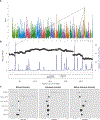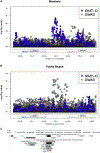An admixture mapping meta-analysis implicates genetic variation at 18q21 with asthma susceptibility in Latinos
- PMID: 30201514
- PMCID: PMC6927816
- DOI: 10.1016/j.jaci.2016.08.057
An admixture mapping meta-analysis implicates genetic variation at 18q21 with asthma susceptibility in Latinos
Abstract
Background: Asthma is a common but complex disease with racial/ethnic differences in prevalence, morbidity, and response to therapies.
Objective: We sought to perform an analysis of genetic ancestry to identify new loci that contribute to asthma susceptibility.
Methods: We leveraged the mixed ancestry of 3902 Latinos and performed an admixture mapping meta-analysis for asthma susceptibility. We replicated associations in an independent study of 3774 Latinos, performed targeted sequencing for fine mapping, and tested for disease correlations with gene expression in the whole blood of more than 500 subjects from 3 racial/ethnic groups.
Results: We identified a genome-wide significant admixture mapping peak at 18q21 in Latinos (P = 6.8 × 10-6), where Native American ancestry was associated with increased risk of asthma (odds ratio [OR], 1.20; 95% CI, 1.07-1.34; P = .002) and European ancestry was associated with protection (OR, 0.86; 95% CI, 0.77-0.96; P = .008). Our findings were replicated in an independent childhood asthma study in Latinos (P = 5.3 × 10-3, combined P = 2.6 × 10-7). Fine mapping of 18q21 in 1978 Latinos identified a significant association with multiple variants 5' of SMAD family member 2 (SMAD2) in Mexicans, whereas a single rare variant in the same window was the top association in Puerto Ricans. Low versus high SMAD2 blood expression was correlated with case status (13.4% lower expression; OR, 3.93; 95% CI, 2.12-7.28; P < .001). In addition, lower expression of SMAD2 was associated with more frequent exacerbations among Puerto Ricans with asthma.
Conclusion: Ancestry at 18q21 was significantly associated with asthma in Latinos and implicated multiple ancestry-informative noncoding variants upstream of SMAD2 with asthma susceptibility. Furthermore, decreased SMAD2 expression in blood was strongly associated with increased asthma risk and increased exacerbations.
Keywords: Asthma; Latinos; SMAD2; admixture mapping; asthma exacerbations; gene expression; meta-analysis; rare variation; targeted sequencing.
Copyright © 2018. Published by Elsevier Inc.
Conflict of interest statement
Disclosure of potential conflict of interest: C. R. Gignoux receives grant support and travel support from the National Institutes of Health (NIH) and holds stock with 23andMe. M. Pino-Yanes receives payments for lectures from Affymetrix. L. H. Uricchio receives grant support from the NIH. J. Galanter receives grant support from the NIH. R. Kumar receives grant support from the NIH. N. Thakur receives grant support from the National Institute of General Medical Sciences (NIGMS) and National Heart, Lung, and Blood Institute (NHLBI). S. S. Oh receives grant funding from the NIH. M. McGarry receives grant support from the NIH. M. A. Seibold receives research support from Pfizer and MedImmune. H. J. Farber receives grant support from the NIH. P. Avila receives grant and travel support from the NIH. E. Brigino-Buenaventura receives grant support, honorarium, and travel support from the Sandler Foundation. A. M. Levin received research support from the NIH. B. A. Raby receives royalties from UpToDate and holds stock with CureSpark. F. J. Martinez receives grant support from the NIH/NHLBI and Johnson & Johnson and serves as a consultant for Copeval. D. L. Nicolae receives grant support from the NIH. S. Sen has received grants from the NIH. L. Keoki Williams receives grant support from the National Institute of Allergy and Infectious Diseases (NIAID), NHLBI, and NIH. R. D. Hernandez receives grant support from the NIH. The rest of the authors declares that they have no relevant conflicts of interest.
Figures




References
-
- National Health Interview Survey (NHIS). Data. 2011 Available at: http://www.cdc.gov/asthma/nhis/2011/table4-1.htm; 2011.
-
- Willemsen G, van Beijsterveldt TCEM, van Baal CGCM, Postma D, Boomsma DI. Heritability of self-reported asthma and allergy: a study in adult Dutch twins, siblings and parents. Twin Res Hum Genet 2008;11:132–42. - PubMed
-
- A catalog of published genome-wide association studies. 2013 Available at: http://www.genome.gov/gwastudies; 2013Accessed March 2013.
-
- Ober C, Hoffjan S. Asthma genetics 2006: the long and winding road to gene discovery. Genes Immun 2006;7:95–100. - PubMed
Publication types
MeSH terms
Substances
Grants and funding
- HHSN261200800001E/CA/NCI NIH HHS/United States
- R25 CA113710/CA/NCI NIH HHS/United States
- KL2 TR000143/TR/NCATS NIH HHS/United States
- R01 DK113003/DK/NIDDK NIH HHS/United States
- R01 AI079139/AI/NIAID NIH HHS/United States
- RC2 HL101651/HL/NHLBI NIH HHS/United States
- R01 HL087699/HL/NHLBI NIH HHS/United States
- U19 AI077439/AI/NIAID NIH HHS/United States
- R01 HL104608/HL/NHLBI NIH HHS/United States
- T32 HG000044/HG/NHGRI NIH HHS/United States
- R01 HL079055/HL/NHLBI NIH HHS/United States
- K22 HG000044/HG/NHGRI NIH HHS/United States
- R01 HL088133/HL/NHLBI NIH HHS/United States
- K23 HL111636/HL/NHLBI NIH HHS/United States
- R01 ES015794/ES/NIEHS NIH HHS/United States
- R01 AI061774/AI/NIAID NIH HHS/United States
- M01 RR000188/RR/NCRR NIH HHS/United States
- R01 HL078885/HL/NHLBI NIH HHS/United States
- RA/ARRA NIH HHS/United States
- T32 CA113710/CA/NCI NIH HHS/United States
- P60 MD006902/MD/NIMHD NIH HHS/United States
- R01 DK064695/DK/NIDDK NIH HHS/United States
- P01 HL132825/HL/NHLBI NIH HHS/United States
- 001/WHO_/World Health Organization/International
- T32 GM007175/GM/NIGMS NIH HHS/United States
- R01 HL118267/HL/NHLBI NIH HHS/United States

